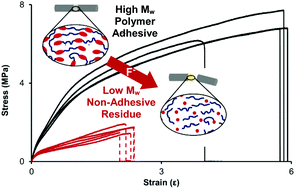Fluoride degradable and thermally debondable polyurethane based adhesive†
Abstract
We report the one-pot, solvent free synthesis of a stimuli-responsive polyurethane (PU) adhesive. The hard domains within the supramolecular PU network contain a silyl protected phenol ‘degradable unit’ (DU). The DU undergoes rapid decomposition (<30 minutes) upon treatment with fluoride ions which causes depolymerisation of the linear PU adhesive. The mechanism of depolymerisation was investigated in solution using 1H NMR spectroscopy by following the degradation of the polymer in the presence of tetra-butylammonium fluoride (TBAF). In the absence of fluoride ions, the material behaves as a typical thermoplastic adhesive, and underwent four adhesion/separation cycles without loss of strength. The fluoride initiated depolymerisation of the PU adhesive in the solution state was verified by GPC analysis, showing reduction in Mn from 26.1 kg mol−1 for the pristine PU to 6.2 kg mol−1 for the degraded material. Degradation studies on solid samples of the PU which had been immersed in acetone/TBAF solution for 30 minutes exhibited a 91% reduction in their modulus of toughness (from 27 to 2 MJ m−3). Lap shear adhesion studies showed the fluoride responsive PU was an excellent material to join metallic, plastic, glass and wood surfaces. Pull adhesion tests confirmed that immersing the adhesive in TBAF/acetone solution resulted in a reduction in strength of up to 40% (from 160 N to 95 N at break) after drying.



 Please wait while we load your content...
Please wait while we load your content...